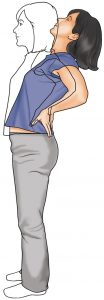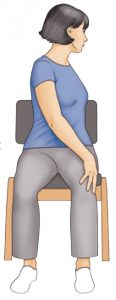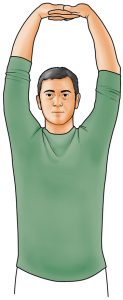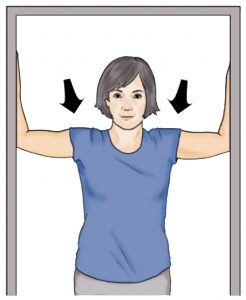How to Become Flexible: Easy Exercises to Keep You Limber and Independent
Flexibility decreases with age, but maintaining your range of motion will affect your mobility and independence in the years ahead. How to become flexible? These easy exercises are a good place to start.
For a moment, try to forget everything you’ve heard about flexibility exercises. Suspend any notions about stretching, warming up, range of motion, and preventing injuries. Now that you’ve hit the reset button, here’s what evidence-based research tells us—and what common sense shows us—about how to become flexible.
The degree of flexibility—the range of motion through which a joint moves—varies widely, depending on the person and the joint. Some people are simply more flexible than others, and some joints allow more range of motion than others. The shoulder is by far the most flexible joint in the body. The knee is one of the least flexible.
What We Can Change, What We Can’t
Becoming flexible is affected by things we can change (physical activity, posture, and getting treatment for orthopedic conditions, for example) and things we cannot (joint structure, pliability of connective tissue, age). If you’re middle-aged or older, you may have noticed how flexibility decreases with age. The exact age varies, but about 50 is when most people begin to experience a loss in flexibility. It may happen to you sooner or later than 50, but it’s going to happen— unless you do something about it.
Benefits of Becoming More Flexible
The evidence is strong that stretching and flexibility exercises can keep you limber. And the list of benefits in remaining flexible is long. You need flexible joints to:

There are countless reasons for us to wonder how to become flexible—chief among them the benefit of staying active longer, allowing us to enjoy favorites pursuits–like gardening. (Photo: Forestpath | Dreamstime.com)
- Walk
- Turn your upper body
- Climb stairs
- Get out of a chair or bed
- Make a bed
- Get dressed and undressed
- Get in and out of a bathtub
- Exercise
- Work in the yard or garden
- Look over your shoulder
- Bathe
- Reach for objects
- Lift objects
- Tie your shoes
- Drive a vehicle
- Get in and out of a vehicle
- Carry groceries
- Participate in a sport or physical activity
In addition, flexibility helps us maintain balance, improve circulation, increase strength, and recover more quickly from injuries.
Mixed Evidence Regarding Injury Prevention
Preventing injuries is not mentioned as one of the benefits of stretching or other flexibility exercises. That’s because the supporting evidence is mixed. Some studies say that stretching immediately before a vigorous activity or sport does not prevent acute or overuse injuries. But famed Boston orthopaedic surgeon, Lyle Micheli, MD, disagrees.
“Regular flexibility training,” Dr. Micheli says, “prevents injuries such as muscle strains, ligament sprains, and shin splints.”
Stretching Rules
Before we get into some exercises for improving flexibility, here are a few rules to keep in mind.
- Don’t stretch first. Stretching is not warming up. Warm up before stretching. Walking, jogging, and light calisthenics are good pre-stretch activities—just enough to break a sweat and increase your pulse rate.
- Stretch until you feel tension or resistance, not to a point when you feel pain.
- Do 6 to 8 exercises/stretches per session, divided among upper body, lower body, and core (trunk).
- Stretch every day, preferably in the morning, but don’t worry if you miss a day.
How to Become Flexible
To get you started on your mission to become more flexible, we present four exercises here, with illustrations: two for the upper body/core and two for the lower body.

Exercise #1: Back extension.
For 60 additional exercises, including those for a sore back, stiff knees, and tight neck and shoulders, pick up UCLA’s “Stay Fit Series” report Easy Exercises for Flexibility.
Exercise #1: Back Extension
- Start in a standing position, with your hands on the small of your back.
- Slowly bend backward as far as comfortably possible.
- Don’t overextend (tilt back) your neck.
- Hold the position for 3 to 5 seconds, then return to the starting position, and repeat.
- Start with 5 to 6 repetitions and work up to 8 to 10.
- Do 2 to 3 sets, resting between sets.

Exercise #2: Seated twists.
Exercise #2: Seated Twists
- Sit up straight in a chair, arms crossed or down alongside your body.
- Rotate your shoulders as far in one direction as comfortably possible.
- Hold for 3 to 5 seconds, then return to the starting position, and repeat to the opposite side, completing 1 set.
- Work up to 8 to 10 reps.
- Do 2 to 3 sets.
- This exercise can be performed in a standing position or holding a golf club or broom with both hands behind your back.

Exercise #3: Overhead reach.
Exercise #3: Overhead Reach
- Start either in a sitting or standing position with your arms up and over your head with fingers interlocked, palms up.
- Extend your arms upward until you feel a stretch in your shoulders and upper back.
- Hold for 10 to 30 seconds, relax, and return to the starting position.
- Do 8 to 10 reps.
- Do 2 to 3 sets.
Note: If you’re dealing with back pain, these types of stretching exercises can be an important part of therapy. Visit our post Low Back Pain? Explore Your Options for Easing the Ache, where you’ll find more exercises to help keep you limber.

Exercise #4: Doorway stretch.
Exercise #4: Shoulder Doorway Stretch
- Stand in front of an open doorway, feet staggered and arms raised so that your upper arms are parallel to the floor.
- Place your palms against the sides of the doorframe and lean forward.
- Hold for 20 to 30 seconds, relax, and return to the starting position.
- Do 1 to 3 reps.
- Do 2 to 3 sets.
Illustrations: Alayna Paquette


 Keep Walking to Lower Your Depression Risk
Keep Walking to Lower Your Depression Risk  Exercises For Mobility
Exercises For Mobility  Living with Dementia Means Having a Greater Fall Risk
Living with Dementia Means Having a Greater Fall Risk 
How to become flexible? Keep a routine of flexibility exercises that will allow you to maintain your independences and continue your favorite activities as you age.
© Nyul | Dreamstime.com